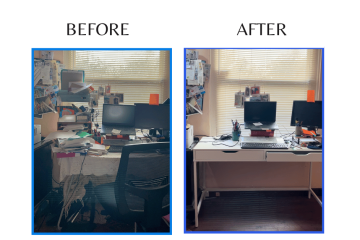Organising your Office

Keen to save time and increase productivity? Get office organising. The first step is figuring out your office style.
Office Minimalist-Very neat and very little on show.
Select clean, plain storage with hidden compartments to keep items out of the way but have easy access when needed. Purchase good quality items that will last.
Meticulous Sorter-Plenty of items in the office but all sorted and put away.
Go for storage with many options for sorting and display. Invest in coloured folders for easy labelling and identification. Storage with lots of compartments is best. Use suspension file boxes, where paperwork is stored efficiently and can be transported.
Visual organiser or Stacker-Work is stacked up in piles, so it can be accessed as needed.
Visual organisers may need to “see” their items, or they may lose track of them. Corral your pile by using broad categories and going vertically up walls. Try not to push your stacks quickly into the background, without thought. By placing your work in broad categories, it can be put away quickly, and then found again with a minimum of searching.
Creative –An abundance of objects allow activity to proceed unhindered.
Minimise the number of items needed to work effectively and don’t overbuy office supplies. Try to have strong boundaries, so work doesn’t spill over into other areas of life. Sort items into zones to prevent losing track of them. Identify the point that a zone is full (for example a cupboard) then immediately sort out and declutter. Cramming more and more into the space will only lead to a decrease in productivity.
Mainly in the Middle-Can be messy or can be very tidy.
Put work away as you go. Best helped by a short tidy up several times a day. Have organising supplies at hand to maximise efficiency using in-drawer organisers that help to categorise see all the space.
For all Organisational types
Have easy access to the office supplies that are used often
Label the outside of storage cupboards, boxes, or drawers.
Only put frequently used items in the top drawers, as this is the most valuable real estate.
Shift the rarely used equipment to the bottom drawer or back of the cupboard.
Colour and Nature to Improve the Mood
Take a moment to work out if your mood needs calming down or revving up.
Studies show that to feel more energetic, go for bright red, bright yellow and neon green.
To feel calmer in your office, consider having blues and greens in your line of sight. Pop an image of the ocean or a forest scene in a picture nearby. Wherever possible, try to orient your desk to look outside your building. Being able to see natural elements in your workspace can boost your feeling of wellbeing by 15%.
To foster creativity, try introducing bright colours, such as yellow, bright green and even bright blue.
Bring Nature in
Plants are a way to add calming green to your office. They also will help purify the air.
Suitable indoor plants that are hard to kill are –
Mother-in-law’s tongue (sansevieria trifasciata)
Peace Lily (Spathiphyllum)
Zanzibar Gem (Zamioculcas zamiifolia)
Ergonomics
Buy the best ergonomic chair to be found in your price range. Ergonomic chairs are a great investment for any person that spends long periods of time sitting down. Set the chair at the height to suit both the body and the desk. Select a height adjustable chair with good lumbar support.
Correct placement of the body in relation to office equipment leads to decreased fatigue. Check that the keyboard, mouse and telephone can be reached comfortably. Check that the screen is at the right height to prevent neck and eye strain. Consider buying a monitor or laptop stand such as Bamboo Monitor Stand
Last Tip – Working from home or back in the office, have a finish-for-the-day ritual before you go home. Do a quick tidy up, power down your computer and/or close the lid of your laptop.
Want to read more from Jane? Take a look at my post about Why Holiday Homes Make Us Happy




